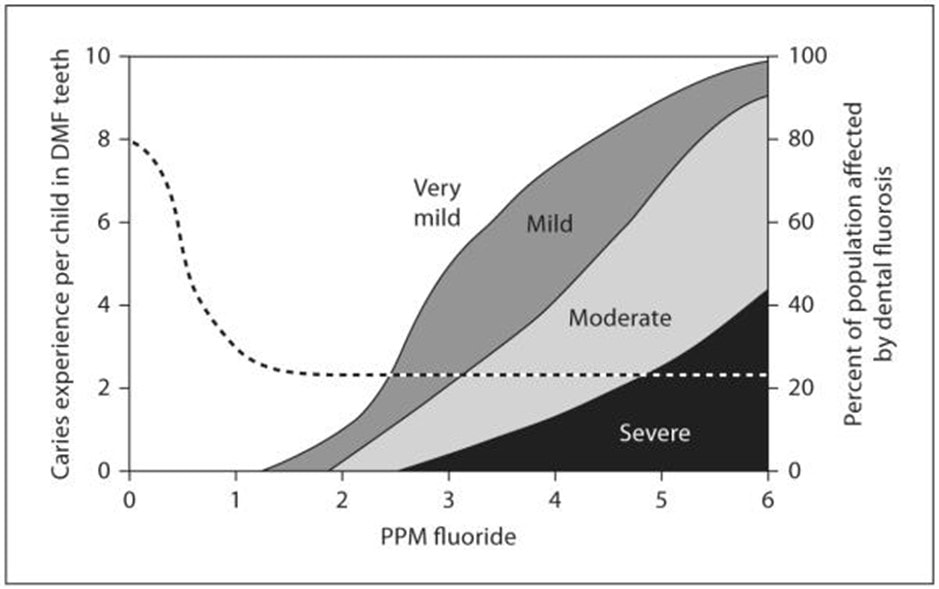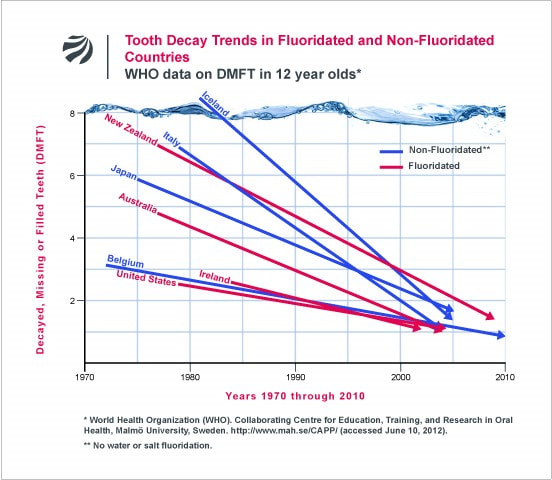|
By Eric Schiller OWSAG received an inquiry and concern regarding fluoride addition to our tap water as a reason to drink bottled water. Below is a response to the inquiry. Thank you for your comments on fluorides in our municipal tap water system. I will respond to your specific points but let me first make some general comments. There are minerals in our drinking water. However, not all minerals are harmful. Some of them are beneficial. That is why some companies sell “mineral water”. Our regulated municipal water has various minerals in it. For example, calcium and magnesium have health benefits for us. When there is excessive calcium and magnesium in the water, we call it ‘hard water’. It is difficult to make soap suds and they leave a deposit when the water evaporates, but in moderate amounts these minerals are healthy. There are some minerals that are highly toxic and have no known health benefits. These are minerals like arsenic, mercury, lead and cadmium. These minerals are truly harmful. There is a third category some elements (not solid minerals), which though dangerous at high levels, can have beneficial effects at low levels. Chlorine is one of these elements. At low levels chlorine kills bacteria. Historically, the introduction of chlorination prevented many water-transmitted diseases (i.e. cholera and diphtheria). This saved millions of lives. However, at high doses, chlorine gas can kill people. Fluoride at low doses can strengthen teeth and bones. However, in higher levels it can disfigure teeth with a brown colouring. This is called dental fluorosis. At the turn of the 20th century some Indigenous peoples in the southern USA had dental fluorosis from fluorides in their natural drinking water. They also had a high resistance to dental cavities. Ottawa municipal tap water has a very low level of fluoride in the water (less than 0.7 mg/litre). As the accompanying graph (from the US Dept. of Health and Human Services) shows, a low level of fluoride does not produce fluorosis. Also, as the graph shows, the number of cavities decreases with the introduction of fluoridation. It is also true that an improved diet, sanitation and dental care has been shown to produce similar results. More on that later. Click the 'Read More' on the right to read the rest of the article. ( Note 1 mg/litre = 1 PPM ) (1) Now to respond to some of your specific statements. You state that to your knowledge “there has never been a study showing that fluoride is safe AND suitable for human consumption”. In fact there are many reports on the use of fluorides to combat dental caries (Scientific World Journal-2014; Harvard PublicHealth-2016; American Dental Association-2018). In a CDC report written and reviewed by 33 medical health professionals, entitled “Recommendations for Using Fluoride to Prevent and Control Dental Caries in the United States (2001) , it is concluded that “ Widespread use of fluoride has been a major factor in the decline of the prevalence and severity of dental caries (i.e. tooth decay) in the United States and other economically developed countries. When used appropriately, fluoride is both safe and effective in preventing dental caries”. (underlining mine) It should be noted that a crucial period for the development of dental fluorosis is among children under the age of 8 years old. This is the time when children’s teeth are still developing. The CDC report says that mild dental fluorosis (which is a cosmetic effect) was noted in 25% of children who drank fluoridated water. However, it also stated that “This level of fluoridation is not considered to be a public health problem”. (underlining mine) (2) Your next quote to consider is, “The USA CDC is an organization that acknowledges up to 65 % of children have dental fluorosis”. It is true that children under 8 years old still have their teeth developing and are thus more susceptible. However, in a recent CDC publication on Community Water Fluoridation (2019) it is stated, “The proper amount of fluoride helps prevent and control tooth decay in children and adults”. (underling mine) The 65% of children with dental fluorosis is high. CDC reported 25% in some cases. Ottawa’s municipal tap water is regulated to have less than 0.7 mg/litre which is well below any dangerous level. (3) Your next statement is “The FDA has acknowledged that they have no safety data on fluoride intake and neurotoxic effects and agreed that recent studies confirm it’s harmful effects , especially lowered IQ in children exposed early in their brain development”. Studies by Environmental Health (2019) state that “Neurotoxicity appeared to be dose dependent, and tentative benchmark dose calculations suggest that safe exposures are likely below currently accepted fluoride concentrations in drinking water” (underling mine). This means that water with fluoride concentrations of < 0.7 mg/l are well below any dangerous level. I refer you to my earlier discussion on the importance of low levels of concentrations with both chlorine and fluoride in water. The American Dental Association (2018) supports fluoridation. They state:
(4) You mentioned that you got concerned about this issue when StatsCan released a report saying “there was no statistical difference in the dental caries between fluoridated Ontario and non-fluorinated Quebec” I think this is an important point. We also have data from various other countries showing that dental caries has decreased in both fluoridated and non fluoridated countries in the past decades, as shown in the graph below. This brings me to my conclusion. Fluoridation, which was first discovered occurring in people who had received fluorides naturally in their groundwater can increase resistance to cavities. However, there are other cultural improvements, such as better diets (i.e. less sugar and more fibres), good sanitation and dental care that can reduce tooth cavities. Some mild dental fluorosis can occur with fluoridated water. However, this is not a life-threatening disease, but a cosmetic issue. Admittedly, excessive levels of fluorides could be dangerous for brain health in children. The low level of fluoride found in municipal tap water (< 0.7 mg/litre) avoids these potential hazards.
Eric Schiller is a founding member of OWSAG and a retired University of Ottawa civil engineering professor.
1 Comment
|
AuthorsBlog posts are written by members and other supporters of OWSAG Archives
November 2021
Categories |



 RSS Feed
RSS Feed
